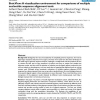Free Online Productivity Tools
i2Speak
i2Symbol
i2OCR
iTex2Img
iWeb2Print
iWeb2Shot
i2Type
iPdf2Split
iPdf2Merge
i2Bopomofo
i2Arabic
i2Style
i2Image
i2PDF
iLatex2Rtf
Sci2ools
BMCBI
2006
2006
SinicView: A visualization environment for comparisons of multiple nucleotide sequence alignment tools
Background: Deluged by the rate and complexity of completed genomic sequences, the need to align longer sequences becomes more urgent, and many more tools have thus been developed. In the initial stage of genomic sequence analysis, a biologist is usually faced with the questions of how to choose the best tool to align sequences of interest and how to analyze and visualize the alignment results, and then with the question of whether poorly aligned regions produced by the tool are indeed not homologous or are just results due to inappropriate alignment tools or scoring systems used. Although several systematic evaluations of multiple sequence alignment (MSA) programs have been proposed, they may not provide a standard-bearer for most biologists because those poorly aligned regions in these evaluations are never discussed. Thus, a tool that allows cross comparison of the alignment results obtained by different tools simultaneously could help a biologist evaluate their correctness and acc...
BMCBI 2006 | Genomic Sequence | Sequences | Tools |
| Added | 10 Dec 2010 |
| Updated | 10 Dec 2010 |
| Type | Journal |
| Year | 2006 |
| Where | BMCBI |
| Authors | Arthur Chun-Chieh Shih, D. T. Lee, Laurent Lin, Chin-Lin Peng, Shiang-Heng Chen, Yu-Wei Wu, Chun-Yi Wong, Meng-Yuan Chou, Tze-Chang Shiao, Mu-Fen Hsieh |
Comments (0)

